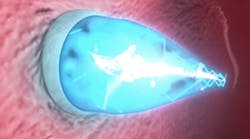Photopolymers are well known in 3D printing. But how do they work and how did they fix a heart? Polymers are known to degrade in UV light and high temperatures. Often degradation causes cross-linking; a result of bonds that link polymer chains to one another. This causes some solid polymers to become brittle. Photopolymers work the same way, only when the liquid polymer cross-links it solidifies or gels. This, solidifying is degradation and means UV light will continue to damage and break down photopolymers. However, there isn’t much UV light inside the human body and, like internal stitches, degrading over time can be exactly what the doctor or engineer ordered.
A recent Wyss Institute report, “Fixing holes in the heart without invasive surgery,” detailed how a team of researchers from Boston Children’s Hospital, the Wyss Institute for Biologically Inspired Engineering at Harvard University, the Harvard John A. Paulson School of Engineering and Applied Sciences (SEAS), and the Karp Lab at Brigham and Women’s Hospital found a new way of closing holes in the heart. Some infants are born with holes in the upper or lower septum (in short, the septum separates the left and right side of the heart). This would require serious heart surgery and cutting into the heart.
Researchers were able to successfully show in an animal study that a flexible catheter can enter the heart without having to cut or stop the heart (see figure). Inserting a catheter into the neck or groin, it then travels to the heart and is placed through the hole in the septum. Two balloons are inflated, one on either side of the hole, that pushes a patch over the hole. UV light then solidifies the patch, which is aided by the reflective interior of the balloon, making sure the patch is not only in place properly, but also gets the UV exposure necessary for the patch to cure over the hole properly. Then, the balloons are deflated and the catheter is removed. Over time, natural tissue will grow over the patch and, when it is no longer needed, the patch will dissolve.
This is a novel approach that could be used on cuts and other medical applications. As the medical field searches for more of these new techniques and materials, the biocompatibility of polymers or other materials becomes imperative.

